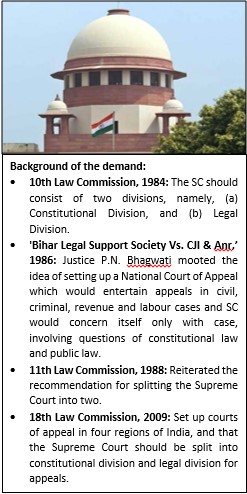Friday, 3rd December 2021
Assisted Reproductive Technology Regulation Bill
In News: The Lok Sabha has passed the Assisted Reproductive Technology Regulation Bill, 2020, recently.
About the News
- The Assisted Reproductive Technology Regulation Bill makes provisions for the safe and ethical practice of assisted reproductive technology (ART) services in the country.
- Another key bill to safeguard the reproductive rights of women is the Surrogacy (Regulation) Bill, 2019 that was passed by Lok Sabha in 2019.
- Need for the ART Bill: The growth of ART clinics in India is among the highest in the world. These are a key part of medical tourism as they offer gamete donation, intrauterine insemination, in-vitro- fertilisation etc. India does not have standard protocols of ART clinics yet.
What is Assisted Reproductive Technology (ART)?
The Bill defines ART to include all techniques that seek to obtain a pregnancy by handling the sperm or the oocyte (immature egg cell) outside the human body and transferring the gamete or the embryo into the reproductive system of a woman.
Examples of ART services include gamete (sperm or oocyte) donation, in-vitro-fertilisation (fertilising an egg in the lab), and gestational surrogacy (the child is not biologically related to surrogate mother).
Understanding ART and Surrogacy Bills
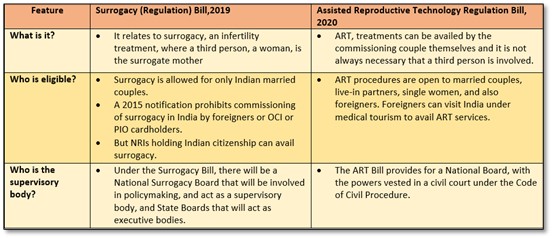
Features of the ART Bill
- ART Bank: ART bank is an organisation set up to supply sperm or semen, oocytes, or oocyte donors to ART clinics or their patients. ART services will apply to women above the legal age of marriage and below 50, and to men above the legal age of marriage and below 55.
- Compliance of the Clinics: Clinics have to ensure that the commissioning couples, women, and donors of gametes are eligible for ART procedures, and that the donor is medically tested. They must ensure the confidentiality of all related data and must establish a grievance cell.
- Safeguard Procedure: The Bill says the clinic shall not perform any treatment or procedure without the written consent of all the parties involved.
- It mandates an insurance coverage in favour of the oocyte donor by the commissioning couple to guarantee compensation for specified losses, damage, complications, or death of the donor during the process.
- Testing for a Disease: There has to be pre-implantation genetic testing to screen the embryo for known, pre-existing, heritable, or genetic diseases.
Where can it be used?
- Reproductive Assistance, Surrogacy, Health
Source:
- Explained: What’s in ART, Surrogacy Bills
- Assisted Reproductive Technology Regulation Bill, 2020
- Assisted Reproductive Technology Regulation Bill proposes national registry of clinics
Image Source:
RBI study on state debt to GDP ratio
In News
RBI in its report, “State Finance: Study of Budgets” has stated that the debt to GDP ratio of states is worryingly higher than the target set by FRBM.
Findings of the report
- The combined debt-to-GDP ratio of States, which stood at 31 % at end-March 2021 is worryingly higher than the target of 20 % to be achieved by 2022-23, as per the recommendations of the Fiscal Responsibility and Budget Management (FRBM) Review Committee.
- The budgeted Gross Fiscal Deficit (GFD) of 3.7 % of GDP for States for the year 2021-22 is lower than the 4 % level recommended by the Fifteenth Finance Commission reflecting the State governments’ intent towards fiscal consolidation.
- In 2021-22 so far (April-September, 2021), the gross and net market borrowings by State governments have been 13 % and 21 % lower than in the corresponding period of the previous year, respectively.
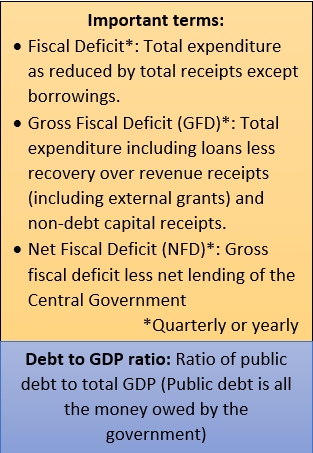
Findings related to Third-tier government
- With the third-tier governments in India playing a frontline role in combating the pandemic, their finances have come under severe strain, forcing them to cut down expenditures and mobilise funding from various sources.
- Increasing the functional autonomy of the civic bodies, strengthening their governance structure and financially empowering them are critical for building resilience and effective interventions at the grass-root level.
- State governments should set up State Finance Commissions (SFC) at regular intervals, in line with the recommendations of 15th Finance Commission
- States may also urge rural and urban local bodies to make audited accounts available online in a timely manner to access grants.
Fiscal measures taken by the states during the pandemic
- States have preferred to borrow from financial accommodation provided by the RBI through short-term borrowing via special drawing facility (SDF) and ways and means advances (WMA).
- Due to the ‘Special Assistance to States for Capital Expenditure’ scheme under of the Atma Nirbhar Bharat Abhiyan, the shortfall in States’ revenue collections did not lead to a similar fall in their capital outlay in 2020-21.
- With a recovery in revenue collection and greater certainty on the GST compensation cess, as the second wave waned, revenue receipts of States have posted robust growth.
- In recent years, the States have been accumulating sizeable cash surpluses in intermediate treasury bills (ITBs) and auction treasury bills (ATBs), although they involve a negative carry of interest rates for the States.
Way forward
- In the medium term, fiscal position of State governments may be improved by undertaking reforms in the power sector as recommended by 15th Finance Commission and specified by the Centre, by
- creating transparent and hassle-free provision of power subsidy to farmers
- preventing leakages of power
- improving the health of the power distribution companies (DISCOMs) by alleviating their liquidity stress in a sustainable manner
- timely payments of State dues to DISCOMS
- Within capital outlay, it is important for the States to channelise expenditure to sectors that crowd in private investments and, optimise multiplier effects and, inter-temporal and inter-sectoral linkages that boost output, employment and productivity.
Where can it be used?
- Debt to GDP ratio, RBI
Sources:
National Multidimensional Poverty Index
In News
‘National Multidimensional Poverty Index: Baseline Report based on NFHS-4 (2015-16)’ has been developed by NITI Aayog, as a precursor to the forthcoming National Multidimensional Poverty Index based on NFHS 5 (2019-20).
What is the National Multidimensional Poverty Index?
- Under the Global Indices for Reforms and Growth (GIRG) initiative, NITI Aayog is the nodal Ministry for the Multidimensional Poverty Index (MPI).
- In line with the Global MPI, NITI Aayog publishes the National MPI which is globally aligned and yet customised to India for drawing up comprehensive Reform Action Plans with the larger goal of improving India’s position in the Global MPI rankings.
- NITI Aayog also ranks States and Union Territories based on their performance on National MPI.
- It is a contribution towards measuring progress towards target 1.2 of the Sustainable Development Goals (SDGs) which aims at reducing “at least by half the proportion of men, women and children of all ages living in poverty in all its dimensions”.
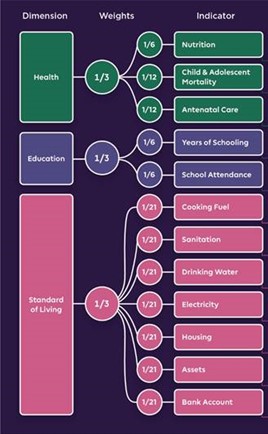
How is it measured?
- The household microdata collected at the unit-level for the National Family Health Survey (NFHS) serves as the basis of the computation of National MPI.
- It captures multiple and simultaneous deprivations faced by households across the three macro dimensions of health, education and living standards.
- As compared to the Global MPI, National MPI of India additionally includes Antenatal Care and Bank Account per household for computation.
- Deprivation = 100 minus achievement in a particular indicator i.e. Score of 0 means no deprivation.
Improvements in NFHS 5 over NFHS 4
NFHS 4 2015-16 serves as a useful source for measuring the situation at baseline as it preceded the full roll out of nationally important flagship schemes. Recently, the summary Fact Sheet of NFHS 5 for all states and UTs has been released. Hence the following observations can be made:
- It suggest improvement in access to clean cooking fuel, sanitation, and electricity which translates to reduction in deprivation.
- Additionally, the State reports released for 22 States and UTs suggest reduction in deprivation in school attendance, drinking water, bank accounts and housing.
- These improvements indicate an overall direction of significant reduction in the incidence of multidimensional poverty in the forthcoming index based on NFHS 5 (2019-20) household micro data.
Where can it be used?
- National multidimensional poverty index, NITI Aayog, Poverty
Source:
International day of persons with disabilities
On December 3, 1992 United Nations General Assembly proclaimed this day as International Day of Persons with Disabilities. This Day aims to promote the rights of people with disabilities and to raise awareness around their well-being. More than 1 billion people globally live with some form of disability and in spite of multiple measures to create awareness around their issues, they are often overlooked during times of emergency. IDPD s is observed to ensure inclusiveness of persons with disabilities and to support their rights in order to empower them towards a life of dignity. Theme for IDPD 2021: “Leadership and participation of persons with disabilities toward an inclusive, accessible and sustainable post-COVID-19 world.”
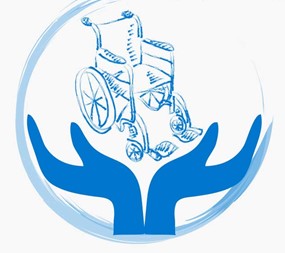
Source:
Institutionalizing the Pre-Legislative Consultation in India
In News
Protests in the recent past over laws such as the farm laws, the RTI Amendment Act, the Transgender Persons (Protection of Rights) Act, etc. have all highlighted the need for a proper Pre- Legislative Consultation Policy.
Current Status on Pre- Legislative Consultation Process
- Simply put, a Pre-legislative consultation policy is a process of engaging with the public on Bills before they are actually put forward in parliament.
- India has adopted the Pre-Legislative Consultation Policy (PLCP) in 2014 on the recommendations of the National Commission to Review the Working of the Constitution (NCRWC) and also the National Advisory Council (NAC).
- According to the principles of the PLCP 2014, various departments and ministries should place draft legislation in the public sphere along with a justifiable reason as to why they want to enact the bill in question.
- Furthermore, details of the social, environmental and financial costs, benefits, challenges, and estimated impact assessment along with an explanation on key legal provisions must be furnished as well.
- All this information must be available to the public for a minimum time span of 30 days.
- The respective departments should also upload the summary of all the feedback that they receive on the circulated draft.
Status of its implementation
- The PLCP, 2014 has been violated on multiple occasions. According to data in “Democratising Law-making: The Tale of PLCP”, 89% of bills introduced in parliament from June 2014 to May 2019 were marked by no or incomplete consultation and secrecy.
- A recent India Spend investigation suggests that the government did not publish the Draft Coastal Zone Law 2019 and ignored 90% of the objections raised by the fishing community and environmental groups.
- It also appears that the government of India does not adequately maintain systematic records of the public consultation process. Countries like the United Kingdom, Canada, and Switzerland have proper institutionalized procedures for pre-legislative consultation.
- The tentative schedule for the current winter session indicates that a total of 29 bills are listed for introduction and passing. Of these, 17 saw no prior consultation while from the 12 that were placed in the public domain, only six adhered to the 30-day deadline.
The Benefits of Pre-Legislative Consultation:
- Improving the quality and outreachof the legislation: As pre-legislative consultation lends a hand for debate and analysis of the draft legislation, it has the potential to improve legislation on the whole. It would enable deliberation and contemplation of the intent and basic guiding principles of the legislation.
- Platform for discussion: Interaction of stakeholders and citizens would facilitate a platform for discussion where the practical, procedural and technical issues involved can be discussed by all the stakeholders.
- Generates public participation: Pre-legislative consultation as a pre-requisite requires stakeholders and people in general to come together and voice their views, perspectives and opinions.
- Sense of ownership: Due to the open nature of the discussion, the voices would gain a sense of ownership of the legislation and not feel divorced from the law or the law making process during its enactment.
- Strengthens the Parliament: In addition to questions being raised, experts and practitioners also indicate further additions and alterations and explanations. This involves citizens at a greater level and strengthens the Parliamentto sense the public sentiment on an issue and strengthen the relationship between them and the public.
- Transparency: A comprehensive pre-legislative consultative policy stresses on the need for transparency and engagement with expertise. A transparent process of drafting of laws will encourage civil society groups to take an active role in public affairs.
- Bridge the gap between the representatives and the citizens: Due to the debate and analyses carried out prior to the Bill being tabled in the Parliament, the ownership of the legislation is felt at the grassroots. This accelerates in both implementing the law in the spirit of the provisions drafted.
Constraints
Institutionalization of public participation through pre-legislative consultation is indeed a requirement. But it is important to contextualize this decision in the prevailing social, political and economic circumstances in India.
- Lack of political will – There is a widespread perception that pre-legislative consultation has now been reduced to a mere “rubber-stamping” exercise and is unresponsive to public opinion. Due to it being an established practice, the department pays lip service to the process.
- Absence of a statutory or constitutional right: Though it is required that the mandates of an approved policy be heeded by all Government departments, the absence of a statutory or constitutional right has watered down the effect of PLCP, 2014.
- Lack of resources and human capacity: Legislative authorities who are to carry out the pre-legislative consultation often lack resources and human capacity to initiate information distribution, public participation, collection of views and suitable platform for deliberation.
- Problem of access: It remains a challenge for ensuring an effective public participation. Generally it is noticed that it is only the business sector and the organized civil society which has access to information and resources to – know the relevant legislation, understand the legislative process and language entailed, forward a submission or a view.
Apart from these, the general lack of education, inadequate access to information and cost and infrastructure constraints that the public institutions face – all of which can impede the effective participation of the public in the legislative process. Moreover, excessive rigorous participation pre-requisites can cause delays and even go to the limit of paralyzing the entire process.
Why it is a must in India?
- While Parliament acts as the representative of the popular will, the engagement of the citizens in the process of enacting legislation must not be restricted to merely vote Members of Parliament into office.
- Article 25 of the International Covenant on Civil and Political Rights vests citizens the right to take part in the conduct of public affairs including the matters of legislation.
- In a country such as ours with such varied and diverse interests, it is crucial that we have policy instruments like PLCP, to ensure that all groups feel their opinions are given the requisite value and recognition.
- The framing of legislation in India is by practice done by members of the bureaucracy based on the inputs from the executive. The flexibility available to the executive in framing legislation, has often led to framing of Bills despite the absence of cogent research, and at times using legislations for the purpose of political expediency.
- The Second Administrative Reforms Commission had emphasised that public consultation in decision making and social auditing through institutionalised mechanisms is vital for the effective functioning of a democracy.
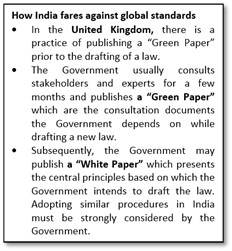
Conclusion and Way Forward
Pre-legislative consultation must be mandatory for all Bills, along with exceptions in case the Government feels that urgent legislation is required to address a particular issue. The consultative process must also extend to the exercise of delegated legislation, in the formulation of rules and guidelines. It is also strongly recommended that a code for pre-legislative consultation is provided statutory sanction, rather than published as a policy or guideline, to improve the chances of compliance by the various ministries. Serious public engagement vis-à-visa Bill in the pre-drafting phase as well as the pre-introduction phase will go a long way in deepening the roots of democracy in our country, and enhance our form of Parliamentary democracy.
Question: Serious public engagement vis-à-vis a Bill in the pre-drafting phase as well as the pre-introduction phase will go a long way in deepening the roots of democracy in our country, and enhance our form of Parliamentary democracy. Critically discuss.
Where can it be used?
- Parliament, Legislation, Consultative Process, Democracy
Sources:
- The need for a proper Pre- Legislative Consultation Policy
- Need of the Hour: Why Pre-Legislative Consultation will make laws better and more inclusive
- Pre-legislative Consultation Policy (PLCP)
- India needs an institutional framework for Pre-legislative Consultations
- Pre-legislative scrutiny: How can citizens be more actively involved?
- A need for the revival of pre-legislative consultation policy in India : precedent of Kerala and South Africa
- Law-Making by and for the People: A Case for Pre-legislative Processes in India
- WORKING THE EFFECTIVENESS OF PRE-LEGISLATIVE CONSULTATION
- With This Policy, Citizens Can Raise Concerns Against Bills Before They Become Laws
- Democratising Lawmaking: The Tale Of Pre-Legislative Consultation Policy
Hornbill Festival - Edukemy Current Affairs
This is image of Hornbill festivities in Nagaland. Hornbill festival reflects the rich culture, lifestyle, and food habits of Nagaland. It is the largest celebration of the Indigenous Warrior Tribes of Nagaland & generally celebrated for 10 days. The festival is called Hornbill, also known as Dhanesh bird. It occupies an important place in the culture and folklore of the Naga tribes. Many tourists within the country and from abroad, visit our 'Ashtalakshmi' Nagaland to enjoy and experience the festival.

Sources:
National wind-solar hybrid policy
- Context: The Ministry of New and Renewable Energy has issued the National Wind-Solar Hybrid Policy.
- Generally, solar and wind power being variable in nature pose certain challenges on grid security and stability.
- However, In India solar and wind resources are complementary to each other and hybridization of these two technologies would help minimize the variability and optimally utilize the infrastructure.
- The main objective of the National wind-solar hybrid policy to provide a framework for promotion of optimal and efficient utilization of wind and solar resources, transmission infrastructure and land reducing the variability in renewable power generation and achieving better grid stability.
- It will help India achieve its ambitious target of reaching 175 GW of installed capacity from renewable energy sources by the year 2022, which includes 100 GW of solar and 60 GW of wind power capacity.

Source:
- National Wind-Solar Hybrid Policy
- National Wind-Solar Hybrid Policy
- National wind-solar hybrid policy
Image Source:
G20 ‘Troika’
- Context: India has recently joined the G20 ‘Troika’.
- Troika refers to the top grouping within the G20 that consists of the current, previous and the incoming presidencies of Indonesia, Italy and India.
- It is the premier forum for international economic cooperation, which reflects a recognition that global prosperity is interdependent and the economic opportunities and challenges are interlinked.
- As a founding member of the G20, India has used the platform to raise issues of vital importance and those that impact on the most vulnerable around the world. It will work closely with Indonesia and Italy to ensure consistency and continuity of the G20’s agenda.
- India will take over the G20 presidency in 2022 from Indonesia.
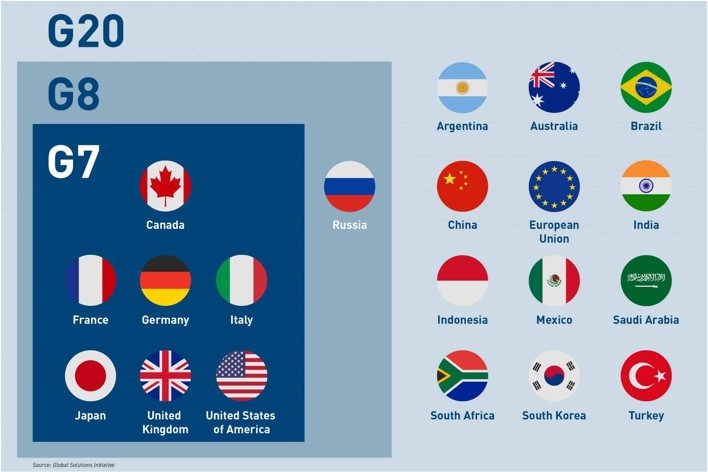
Source:
- India joins G20’s Troika with Indonesia and Italy
- India joins G20 Troika, to assume G20 presidency on Dec 1 next year
- India joins G20 Troika, to work to ensure consistency of agenda
Image Source:
SMILE Scheme
- Context: The Ministry of Social Justice and Empowerment has formulated “SMILE” scheme.
- SMILE - Support for Marginalized Individuals for Livelihood and Enterprise” is a scheme that covers comprehensive measures for persons who are engaged in the act of begging.
- It exclusively focuses on rehabilitation, provision of medical facilities, counselling, basic documentation, education, skill development, economic linkages and so on.
- The Scheme provides for the use of the existing shelter homes available with the State/UT Governments and Urban local bodies for rehabilitation such persons.
- It will be implemented with the support of State/UT Governments/Local Urban Bodies, Voluntary Organizations, Community Based Organizations (CBOs) , institutions and others.
- Pilot projects have been initiated in 10 cities namely Delhi, Bangalore, Chennai, Hyderabad, Indore, Lucknow, Mumbai, Nagpur, Patna and Ahmadabad.
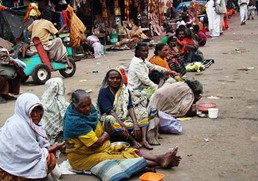
Source:
Image Source:
Facebook Protect
- Context: Facebook has recently designed a new feature- Facebook Protect.
- Facebook Protect is a security program for the people that are most likely to be highly targeted by malicious hackers or other adversarial threats and even state-sponsored attacks.
- These include human rights defenders, journalists and activists, and are often at the centre of public debate as they hold governments and companies accountable.
- As part of the program, those users who fall within these groups will soon start seeing a prompt from Facebook asking them to turn on the ‘Facebook Protect’ option.
- The program is designed to protect their accounts against cyberattacks and also mandates that the users turn on Two Factor Authentication (2FA) for their accounts.
- This requires an OTP either via SMS or a third-party authenticator app in order to access the account.
- The programme was first tested in the US in 2018 and expanded more broadly during the US 2020 elections and is planned to be rolled out in nearly 50 countries by the end of the year.

Source:
- Explained: What is Facebook Protect, who can get it and why
- Facebook Protect expands to more countries, including India; will offer extra protection to high-risk accounts
Image Source:
India needs a 20-year semiconductor strategy: HT
Essence: The article focuses on the upcoming policy specifically for semiconductor manufacturing units in India. The article has explained the reasons as why semiconductor manufacturing is an unviable option for India. The author suggests that instead, India should aim to become a key player in a trusted, plurilateral semiconductor ecosystem that keeps key adversaries out.
To achieve this there are certain prerequisites like a 20 year roadmap, adequate financial support, strategic cooperation on semiconductors, favorable trade policies and robust infrastructure. If India wants to advance its position on technological front it should focus on materializing on its semiconductor design in which it has comparative advantage along with the confluence of pre requisites mentioned above.
Why you should read this article?
- To understand India’s position in semiconductor market.
- To understand essentials that are required if India wants to advance its position in the semiconductor ecosystem.
Source:
A white touch to a refreshed green revolution: TH
Essence: With the withdrawal of the three farm laws Government needs to find better ways to increase farmers’ income. India can take lessons from the ‘White Revolution’ to benefit its crop growing farmers. At the same time, it is necessary to differentiate it from the ‘Green Revolution’. Green Revolution was largely a technocratic enterprise driven by science, principle of efficiency and stressed on increasing output of agriculture. On the other hand, White Revolution was a socio-economic enterprise based on the principle of equity. Undoubtedly, Amul became India’s most loved brand and competed with international brands.
A new step towards increasing farmer’s incomes should take into account few important aspects. It should focus on the social side of enterprise and not just business side, local environment and people should be the principal resources, an evolutionary and not drastic revolutionary process should be used for transformation in agriculture, utilization of science should be such that it can be understood and used by common man. According to Kurian, leader of White Revolution in India, a top- down ownership of enterprises could not be a solution in a democratic economic governance which keeps people at its centre.
Why to read this article?
- To understand what should be the principles for a new policy to increase farmer’s income after the withdrawal of the three farm laws.
- To realize that how Amul model (as a Case Study) and White Revolution has great potential to aid India’s crop growing farmers and compare it with India’s Green Revolution.
- This article becomes important as India celebrates 100th birth anniversary of Varghese Kurien, the leader of White Revolution and due to the farmer’s agitation that India witnessed. Therefore, the relevance is from the perspective of Post-Independence India (GS I), Cooperatives and Agricultural Policies (GS II) and Agriculture Sector (GS III).
Source:
Countering China’s expanded footprint and influence in South Asia: HT
Essence: The author focuses on increased presence of Chinese interests in South Asian region ranging from infrastructure creation, financing projects, governance, political and security cooperation. China has been a favoured partner because it has understood the developmental demands and created solutions to address the priority areas in these countries- Sri Lanka, Bangladesh Nepal and Maldives. But such associations do come at a cost of increased Chinese dominance and hegemony, which these nations try to counter.
This is where the other interested and potential partners could initiate engagement based on merit, eg in processes that involve addressing systemic deficiencies in governance- oversight, investment screening and contract review of the projects.
Why you should read this article?
- To understand the issues with China as a contracting partner in projects with developing countries.
- To know the demands and needs of developing countries in Asia.
Source:
Conservation led to devastation
Background:
- Rainwater harvesting is one the major source of conservation of water, which has been made a mandatory norm in Tamil Nadu in 2003.
- But, this water conservation disturbed the natural systems.
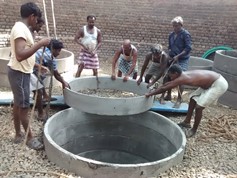
How un-monitored conservation led to devastation?
- Rainwater harvesting was made the norm form all residential complexes in Tamil Nadu.
- Rainwater harvesting wells were built between residential compounds and tarred roads and helped maintain and recharge groundwater levels.
- Over storage in these wells led to flooding of the region.
- Constructing an SWD permanently damages a potential source of groundwater. Built on the side of the roads, they collect urban run-off which is then dumped into the sea. They are paved systems which prevent the percolation of rainwater into the ground and essentially contribute to an anti-harvesting process.
- The concrete doesn’t allow the ground to absorb rainwater, which eventually overflows into the low-lying areas.
Quote:
You can’t force people to care about the natural environment, but if you encourage them to connect with it, they just might.” — Jennifer Nini
Source:
Share the article
Get Latest Updates on Offers, Event dates, and free Mentorship sessions.

Get in touch with our Expert Academic Counsellors 👋
FAQs
UPSC Daily Current Affairs focuses on learning current events on a daily basis. An aspirant needs to study regular and updated information about current events, news, and relevant topics that are important for UPSC aspirants. It covers national and international affairs, government policies, socio-economic issues, science and technology advancements, and more.
UPSC Daily Current Affairs provides aspirants with a concise and comprehensive overview of the latest happenings and developments across various fields. It helps aspirants stay updated with current affairs and provides them with valuable insights and analysis, which are essential for answering questions in the UPSC examinations. It enhances their knowledge, analytical skills, and ability to connect current affairs with the UPSC syllabus.
UPSC Daily Current Affairs covers a wide range of topics, including politics, economics, science and technology, environment, social issues, governance, international relations, and more. It offers news summaries, in-depth analyses, editorials, opinion pieces, and relevant study materials. It also provides practice questions and quizzes to help aspirants test their understanding of current affairs.
Edukemy's UPSC Daily Current Affairs can be accessed through:
- UPSC Daily Current Affairs can be accessed through Current Affairs tab at the top of the Main Page of Edukemy.
- Edukemy Mobile app: The Daily Current Affairs can also be access through Edukemy Mobile App.
- Social media: Follow Edukemy’s official social media accounts or pages that provide UPSC Daily Current Affairs updates, including Facebook, Twitter, or Telegram channels.


